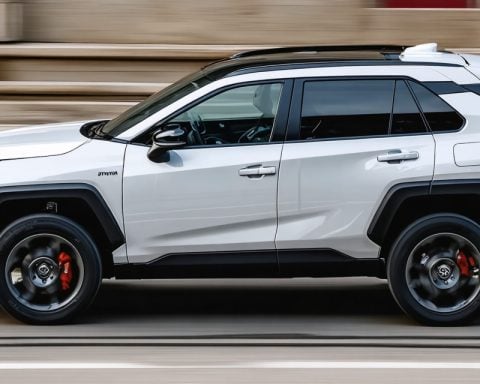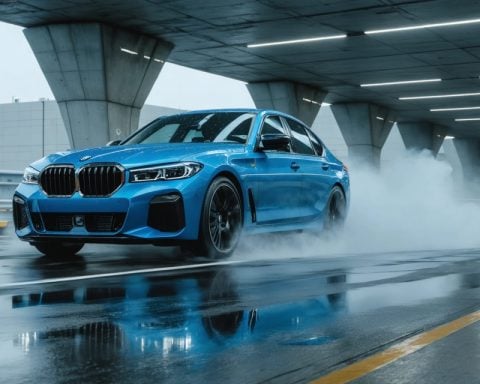Ingenious Integration of Modern Technology with Classic Aesthetics
In a remarkable blend of tradition and innovation, an electric vehicle (EV) charger installation expert has found a way to install modern EV charging technology while preserving the charm of an old farmhouse. Neil McGavock, from the company Powered EVNI, specializing in EV installations throughout Northern Ireland, was approached by a homeowner seeking to charge their electric vehicle without compromising the character of their historic residence.
The homeowner proposed a creative idea: to conceal the charger within a classic red postbox, an iconic symbol of rural architecture. McGavock found this approach both unique and practical, noting that it would seamlessly integrate with the farmhouse’s aesthetic.
After consultations, the Ohme ePod charger was chosen for installation due to its compact design and efficient power output of 7kW, capable of fully charging an EV overnight. To ensure stability, additional metal reinforcements were added, securing the postbox to the farmhouse’s wall while accommodating the charging unit discreetly inside.
Remarkably, the postbox retains its functionality; the key-operated door allows the homeowner to lock the charger away when not in use, cleverly hiding modern technology behind a nostalgic facade. With the installation complete, both McGavock and the homeowner expressed satisfaction with the accomplished fusion of functionality and historical preservation.
Innovative Harmony: Merging Modern EV Technology with Historic Aesthetics
In a fascinating intersection of progress and preservation, an electric vehicle (EV) charger installation expert named Neil McGavock has showcased how modern technology can coexist harmoniously with historical craftsmanship. Tasked with installing a charging station at an old farmhouse in Northern Ireland, McGavock successfully integrated the Ohme ePod charger within a classic red postbox. This innovative installation preserves the visual charm of the residence while facilitating the transition to electric mobility.
The installation not only reflects a commitment to maintaining the aesthetic integrity of historic architecture but also highlights a broader movement towards sustainable energy solutions. By choosing to embed the charger within a nostalgic icon of rural life, the homeowner demonstrates that embracing modern technology does not require sacrificing cultural heritage.
Environmental Impact and Future Considerations
The emergence of electric vehicles is crucial in the battle against climate change, as they offer a pathway to reduce greenhouse gas emissions from the transportation sector. Each EV that is used in place of a conventional gasoline vehicle diminishes reliance on fossil fuels, promoting a cleaner atmosphere. However, the proliferation of charging stations plays an equally vital role in encouraging the adoption of EVs.
By installing an EV charger discreetly within a historic postbox, McGavock’s project exemplifies how thoughtful integration of technology can respect and invigorate community heritage. This approach not only serves the need for accessible charging infrastructure but also ensures that rural areas can transition to more sustainable energy practices without losing their unique identity.
Moreover, this innovative project raises broader questions about urban planning and development as we move deeper into the 21st century. As cities expand and populations increase, the necessity for eco-friendly solutions grows ever more urgent. The architectural preservation seen in this case can inspire future projects aiming to marry technology with tradition through similar creative integrations. Sustainable urban environments may involve preserving historical landmarks while retrofitting them with green technologies.
The economic implications of such efforts are also noteworthy. By investing in EV infrastructure that respects local heritage, communities can attract eco-conscious tourists and residents who value sustainability and historical preservation. This synergy can lead to job creation in both the conservation and technology sectors.
In summary, Neil McGavock’s integration of modern EV charging technology into a classic farmhouse illustrates a promising path forward where innovation does not erase the past but rather enhances it. As humanity faces pressing environmental challenges, projects like this can pave the way for a future where sustainable living is embraced alongside cultural appreciation, ensuring that progress and history walk hand in hand toward a greener world.
Reviving Tradition: How an EV Charger Became a Vintage Postbox Masterpiece
Ingenious Integration of Modern Technology with Classic Aesthetics
In a fascinating intersection of tradition and technology, the installation of electric vehicle (EV) chargers is evolving, allowing historical properties to embrace modern conveniences without sacrificing their unique character. The recent project led by Neil McGavock from Powered EVNI in Northern Ireland exemplifies this trend, showcasing how home improvements can respect and enhance classic architecture.
The Creative Approach to EV Charging
Homeowners are increasingly looking for innovative solutions to integrate EV charging technology in their residences. By proposing to conceal an EV charger within a classic red postbox, a homeowner successfully merged modern functionality with the timeless charm of rural aesthetics. This creative solution not only maintains the historical integrity of the farmhouse but also enhances its visual appeal.
Key Features of the Installed Ohme ePod Charger
– Power Output: 7kW, allowing for efficient overnight charging.
– Design: Compact and discreet, designed to blend seamlessly with various aesthetics.
– Security: The key-operated door of the postbox allows the homeowner to secure the charger when it’s not in use, preventing theft and ensuring the installation remains an integral part of the home’s character.
Pros and Cons of Concealed EV Charger Installations
Pros:
– Aesthetic Preservation: Maintains the historical look of the property.
– Increased Property Value: Modern amenities such as EV chargers can increase the appeal and value of a property.
– Functionality: Provides a practical solution for EV owners without compromising on style.
Cons:
– Initial Cost: The custom installation can be more expensive than traditional installations.
– Limited Accessibility: Depending on design, access to the charger may be less convenient than standard units.
– Maintenance Issues: Older structures might require additional adjustments to accommodate modern technology safely.
Trends in EV Charge Installations
The integration of EV chargers into classical architecture is not just a local trend but a growing phenomenon worldwide. Homeowners of historic properties are innovating with designs that:
– Utilize camouflage techniques to blend modern technology with historical features.
– Increase the use of sustainable materials in installation to emphasize eco-friendly practices.
– Foster community awareness and engagement regarding eco-friendly transportation options.
Insights into the Future of EV Charging
As the demand for electric vehicles rises, so will the need for creative installations that respect and preserve history. Companies like Powered EVNI are paving the way for future innovations that can:
– Offer customizable solutions for different types of historical properties.
– Embrace smart technology, allowing homeowners to monitor and control charging through mobile apps for greater convenience.
– Collaborate with heritage organizations to ensure compliance with preservation guidelines while promoting sustainability.
In conclusion, innovations like the concealed EV charger in a classic postbox demonstrate that modern technology can coexist beautifully with historical characteristics. Such projects can inspire a broader movement toward greener, more sustainable living without compromising on charm and tradition.
For more insights on sustainable living and electric vehicle solutions, visit PV Advanced Energy.













